THE MEATMAKERS: A TALE OF TWO RIFLES
 Virginia opened a special muzzle loading rifle season in, I think, 1990 or 1991. I didn’t pay much attention to it. I’d only been here for four years at that point, and hadn’t had much success in killing a deer under any circumstances, partly because of not having much land to hunt on, and partly because I wasn’t a very good hunter. It had been frustrating enough using a centerfire rifle, and I didn’t see how having another two weeks of fruitless effort was going to be much fun.
Virginia opened a special muzzle loading rifle season in, I think, 1990 or 1991. I didn’t pay much attention to it. I’d only been here for four years at that point, and hadn’t had much success in killing a deer under any circumstances, partly because of not having much land to hunt on, and partly because I wasn’t a very good hunter. It had been frustrating enough using a centerfire rifle, and I didn’t see how having another two weeks of fruitless effort was going to be much fun.
However, my luck began to change in 1992, when I killed my first Virginia deer. In the late 80's I’d got permission to hunt Spruce Run Farm, and after getting a couple of seasons under my belt, I was beginning to figure the property out: in the Fall of 1992 I shot a doe out there. The following year I decided that perhaps this muzzle loading thing wasn’t a bad idea, something worth trying. My sole motivation was to increase the time available to me to hunt. Deer seasons still opened on Mondays then, so I had to take annual leave to hunt on Opening Day, but in my first years at Virginia Tech as an un-tenured junior faculty member, I was working 80-hour weeks and not taking any vacation time at all. After I was tenured in 1993, things got a lot less tense and I had the opportunity for some down time. Finally, I'd be able to take a Monday off now and then to hunt.
So I bought my first muzzle loading rifle. It was a CVA “Blazer,” purchased at the then-extant Rose’s store on University City Boulevard. I didn’t want to spend too much, so I bought the least expensive rifle I could find. 
The Blazer was, to be charitable, a crude piece of junk. I bought it in kit form, for all of $65, and it was somewhat overpriced at that. The “action” was a folded sheet metal box with two cross pins to hold the cast-metal hammer and trigger in place, plus a couple of coil springs. The nipple was screwed directly into the rear end of the barrel. It was very nearly as minimalist a design as a zip gun, and could easily have been made in a high school shop class or a prison. It had abominable sights, wasn’t very accurate, and I’m not entirely sure it was actually legal under the law as written at the time. The DGIF—probably thinking in terms of a “primitive weapons season”—originally defined “muzzle loading rifles” so as to more or less mandate sidelock actions. While the Blazer was surely “primitive” by any standard, a sidelock is most certainly wasn’t. Rather, it was an early form of in-line. The exposed hammer impacted on the completely exposed nipple that was conveniently positioned dead center at the end of the barrel, about four inches in front of my right eye. It made me glad I wear eyeglasses with shatterproof lenses.
 Misfires were pretty common with this clunker. The important parts were completely open to the elements, not even partially enclosed as in striker-fired in-lines. A brief snow flurry could put it out of action: the very first time I tried to shoot a deer with it, a single snowflake landed on the nipple, melted, wicking moisture into the #11 cap, so that when I pulled the trigger…I heard CLICK! instead of BANG! Then I watched the deer run off, laughing.
Misfires were pretty common with this clunker. The important parts were completely open to the elements, not even partially enclosed as in striker-fired in-lines. A brief snow flurry could put it out of action: the very first time I tried to shoot a deer with it, a single snowflake landed on the nipple, melted, wicking moisture into the #11 cap, so that when I pulled the trigger…I heard CLICK! instead of BANG! Then I watched the deer run off, laughing.
The Blazer wasn’t much of a firearm, but it taught me a lot about being a muzzle loading hunter, most especially about the mindset that’s needed to use “primitive” weapons successfully. The ritualistic routine that had to be followed—fanatical attention to clearing the flash channel, wiring out the nipple every time before capping it, never, ever putting the same cap on it twice, always using a new one—is now as automatic to me as saying Mass is to an elderly priest. More to the point, I think that rifle made me a better hunter. It taught me that I have one and only one opportunity for a kill; its foibles compelled me to develop fire discipline and patience, to let the deer get close and then closer still before risking a shot.
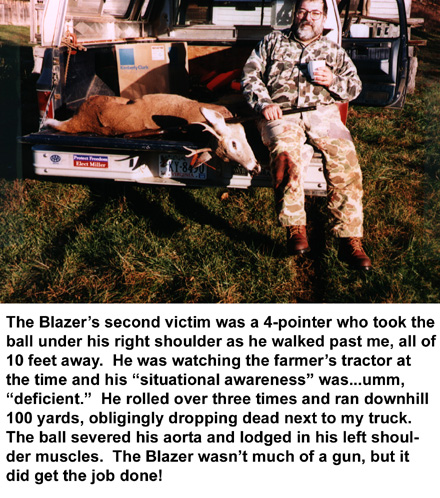 The Blazer was a .50-caliber round-ball-only gun rifled at the classic rate of 1 turn in 66 inches. I was a little hesitant about how effective patched round balls would be, but it cured me of that notion, too.
The Blazer was a .50-caliber round-ball-only gun rifled at the classic rate of 1 turn in 66 inches. I was a little hesitant about how effective patched round balls would be, but it cured me of that notion, too.
A lot of people who've never used them scoff at round balls, and if you believe what you read in Cabela’s and Bass Pro Shops' catalogs you'd think whitetails were covered in six-inch armor plate that demands a minimum of a 400 grain conical over 150 grains of powder to get through. Not so. Even a 185-grain .50 round ball often will go all the way through a deer, even if it hits bone. I have a couple of off-side shoulder blades to prove this.
Lead balls don’t seem to deform much at BP velocities. If they have a bit of hardness to them (as home-cast balls 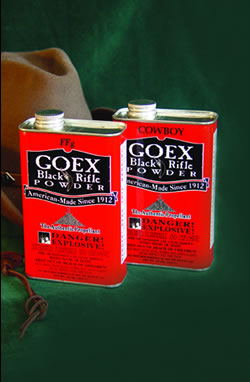 usually do) they’ll punch straight on through whatever’s in front of them. They are very much better killers than might be expected, with minimal meat damage thanks to a very large wound channel.
usually do) they’ll punch straight on through whatever’s in front of them. They are very much better killers than might be expected, with minimal meat damage thanks to a very large wound channel.
Another thing the Blazer taught me was the superiority of real black powder over Pyrodex. Black powder is much easier to ignite. I have no experience with other synthetics, but I found Pyrodex to be very hard to set off, despite the Blazer’s in-line ignition. I got hangfires with it (when I didn’t get misfires). I tried some GOEX FFg and have never looked back: misfires and hangfires were completely eliminated when I switched and provided I was careful to keep the flash channel clear. I believe the current popularity of the shotgun-primer-ignition in-lines is mainly due to the difficulty most people encounter trying to set off synthetic powders with #11 caps. The synthetics are so insensitive that the hot flame of a shotgun primer is far more reliable. Real BP is hard to find, but worth the effort for its greater reliability and stability.
Rudimentary as it was, it worked well enough, once I learned its quirks and could get it to go off when I wanted it to. Eventually I killed three deer with that ratty little gun before giving it to a young man who’d helped me prune an apple tree in my yard, and I hope he’s still using it.
In October of 1996, I decided I had to step up from the Blazer. I bought a Thompson/Center New Englander in .54 caliber at a gun show, strongly influenced by my friend Rick Fell’s New Englander (a .50) that he'd used for several seasons. His rifle was reliable, accurate, and deadly. But I wanted a .54, not a .50.

I’m a believer in making big holes in animals: the bigger those holes, the better so far as I am concerned. As Elmer Keith said, “You need two holes: one to let the air in and one to let the blood out.” With BP rifles using round balls the only practical way to increase effectiveness is to go to a bigger bore size. A .50 is fine for whitetails, but there’s a small possibility that some day I may be able to hunt larger game—moose is one of my interests—so I wanted a bigger bullet. The New Englander was available in .54, and it was rifled 1:48” so—unlike the 1:66” Blazer—it can also use conical projectiles. I’d probably go to a conical bullet for really big game, but there isn’t a whitetail in Virginia that requires them. Lewis and Clark made it all the way to the Pacific and back using round balls, and who am I to argue with a record like that?
 I tarted my new rifle up with a tang sight and a “Kap Kover” on a thong to protect the nipple (and act as a safety device), and I was ready to hunt, but I didn't get to use it in 1996, as I hadn't had time to sight it in. The CVA did its Retirement Tour that year, ending in a “Blazer of Glory” with two more kills to its credit.
I tarted my new rifle up with a tang sight and a “Kap Kover” on a thong to protect the nipple (and act as a safety device), and I was ready to hunt, but I didn't get to use it in 1996, as I hadn't had time to sight it in. The CVA did its Retirement Tour that year, ending in a “Blazer of Glory” with two more kills to its credit.
The New Englander's first season was 1997, which was a bust. I killed a couple of deer with my .30-06, but nothing with the New Englander. The 1998 season went well for me, but the New Englander remained un-blooded. I was beginning to think I'd acquired a wallflower.
Virginia’s two-phase BP season opens a week earlier east of the Blue Ridge than it does up here in the mountains west of it. I have a place to hunt in Amherst County, which is conveniently east of the line; bag limits are higher on that side of the Ridge, too, and either sex is legal the entire season. It’s a meat hunter’s location, no doubt.
So in the early BP season of 1999 I loaded up my gear and headed out to a spot where I'd seen deer while squirrel hunting two weeks before. A doe and a fawn had walked past me, eyeballed me curiously, and wandered off.
At 7:15 I heard a commotion in the woods to my left, cocked the gun, and got ready...ten seconds later two does came streaking past me about 10 yards off, hell-for-leather, running as fast as they could, but without their tails up. The reason why was evident: hot on their heels was a big buck—didn't get to count points, but he certainly had 8, maybe more, and he was very heavy-beamed—intent on spreading his genes as widely as he could. The does were having none of it, and desperately running to preserve their maidenly virtue. I never got a shot off: they were going so fast I doubt if I'd have connected with buckshot, let alone a rifle. Well, that's why they call it "hunting."
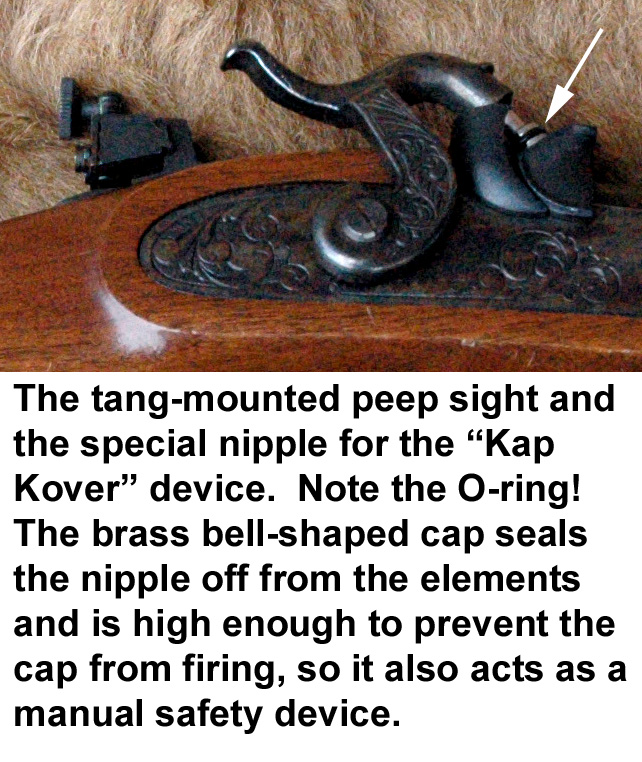 At 9:00 AM, I came in to warm up and eat something, then went back out about an hour later to a different spot, in a good-sized stand of white oaks. There was a little wagon road that dipped down along the side of the hill the house sits on, the sort of natural, easy route deer tend to follow. "Perfect," said I to myself, "this road intersects the trail just below the crest of the ridge, and it has a food source at one end and a bedding area at the other. Good spot to wait and see who shows up."
At 9:00 AM, I came in to warm up and eat something, then went back out about an hour later to a different spot, in a good-sized stand of white oaks. There was a little wagon road that dipped down along the side of the hill the house sits on, the sort of natural, easy route deer tend to follow. "Perfect," said I to myself, "this road intersects the trail just below the crest of the ridge, and it has a food source at one end and a bedding area at the other. Good spot to wait and see who shows up."
At this spot is a big flat rock that juts vertically from the ground, perhaps ten feet above the road and looking down onto it. I don't do tree stands, but this place had all of the advantages of one without the risks. It was enough higher than the road that I'd be well above a deer's line of sight. I also gave me a good view in both directions and a look down into the swale below it in case someone came up to the road rather than along it. Better yet, it completely shielded me from any view from behind. Best of all, as the rock is higher than my head and a good ten feet wide, it forms a "wind shadow" that prevents my scent from being carried down to the road and swale. I've used this "wind shadow" phenomenon many times before, with good results.
I was dead tired after a late night, a long drive and an early rise, so between 10:00 and 1:30 or so I dozed, shielded by the rock. About 1:45 I woke up with that feeling all hunters have experienced at some time: that everything is set, and something is going to happen, soon. I don't know why, but things felt right. I knew that when the deer started to move again, I was in the right place at the right time, but why I felt that way I don't understand, and don't want to. If I get too analytical about it, I might lose that subliminal perception of "rightness" that hasn't failed me yet.
After half an hour of watching, I began to grow a little bored, and pulled out a paperback novel. I’ve been called crazy for this habit I have of reading on a deer stand, but the fact is, I almost always hear deer before seeing them, and it never seems to have hurt my odds to keep my brain running with a light-weight story while my ears stand sentry-go.
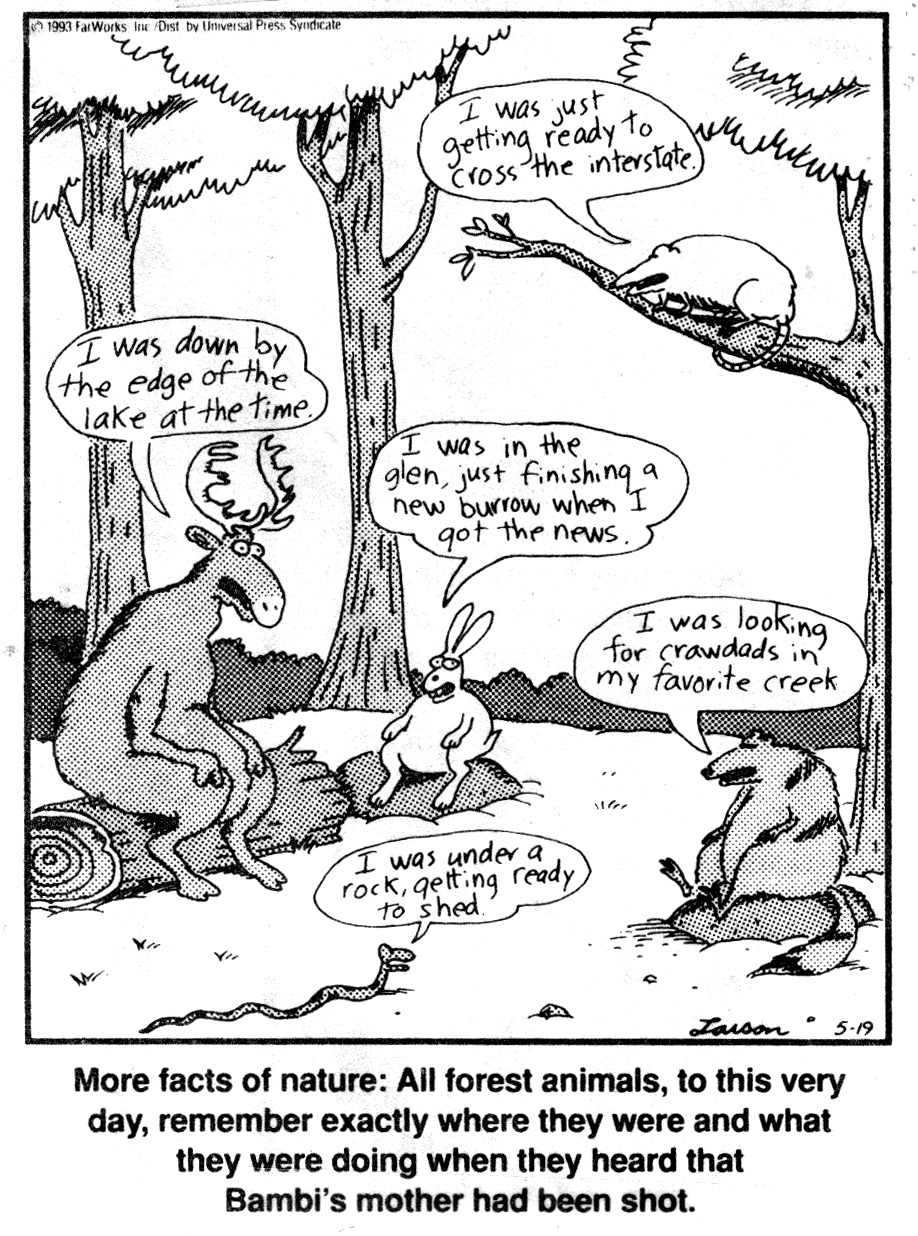 At 3:30, the left ear alerted me to a crunch-crunch-crunch in the leaves. I put down my book, and lo, there was a doe, a fawn following her, coming along the road, just about where I thought they'd be. Now, I think—I'm almost certain—this was the same doe and fawn I'd seen a couple of weeks earlier while squirrel hunting. Again, I don't know why, but surely deer, like dogs, have individual "faces" and as I have a very good visual memory, I probably had a picture of this pair in my mental register. I’d have needed DNA analysis to prove the case, but I'd be willing to bet a sizeable sum it was them.
At 3:30, the left ear alerted me to a crunch-crunch-crunch in the leaves. I put down my book, and lo, there was a doe, a fawn following her, coming along the road, just about where I thought they'd be. Now, I think—I'm almost certain—this was the same doe and fawn I'd seen a couple of weeks earlier while squirrel hunting. Again, I don't know why, but surely deer, like dogs, have individual "faces" and as I have a very good visual memory, I probably had a picture of this pair in my mental register. I’d have needed DNA analysis to prove the case, but I'd be willing to bet a sizeable sum it was them.
Mama was mooching along the trail, snarfing acorns, and Baby was behind her, doing the same. I let Mama get clear of a tree and then took the shot. I was using 80 grains of FFg under the ball, an RWS cap and one of those Ox-Yoke felt wads between the powder charge and ball. Again, to judge by the catalogs’ ad copy, this load would barely qualify as adequate for a squirrel, but it sure did that doe.
She had her head down and I put the bead on the middle of her back, between the shoulder blades. At the shot, she dropped and started to kick, while Baby watched in some confusion. The doe tried to get up and move, but couldn't manage it; just sort of flopped and tried to stand but had no control. I reloaded, thinking another shot would be needed; but by the time I got to her it was all over. The death throes hadn't lasted more than 10 or 15 seconds. Baby took off when I got up to come over, I hope with a lesson learned.
The entry wound was at exactly the spot I'd aimed for; just slightly to the left of her centerline. The spine was clipped in half—that’s why she couldn’t move—and there was a thumb-sized hole in the left lung, from top to bottom. Her chest was full of blood, of course. But there was remarkably little "mess" of the sort you expect from a high-speed expanding bullet. I later paced off the shot at 16 yards, pretty typical in those dense woods. The bullet had gone into the liver; I didn't see an exit wound, but I’m sure it went all the way through. It might have been somewhere in the gut pile (I didn't root around and look for it, my intellectual curiosity isn't that great) but the exit wound from a round ball at moderate velocity is usually pretty small and covered with hair.
I dragged her about 50 yards—uphill, damn it, and my muscles told me about that later—to the edge of the woods, then went to get my truck. Rick had arrived by then and was on his way out to a stand near where I had first sat. I wished him luck and then spent the next 20 minutes trying to get that fat old girl into the bed. At a guess I'd say that dressed she was about 80-90 pounds, say 125 pounds live weight. A matronly lady, whose descendants no doubt still wander Bill Fell’s farm today. She was heavy enough that I couldn't lift her bodily. A loose, floppy dead deer is an awkward thing to manipulate, but eventually I managed it, and took her and hung her in the tool shed. In the meantime, I heard Rick's gun go off.
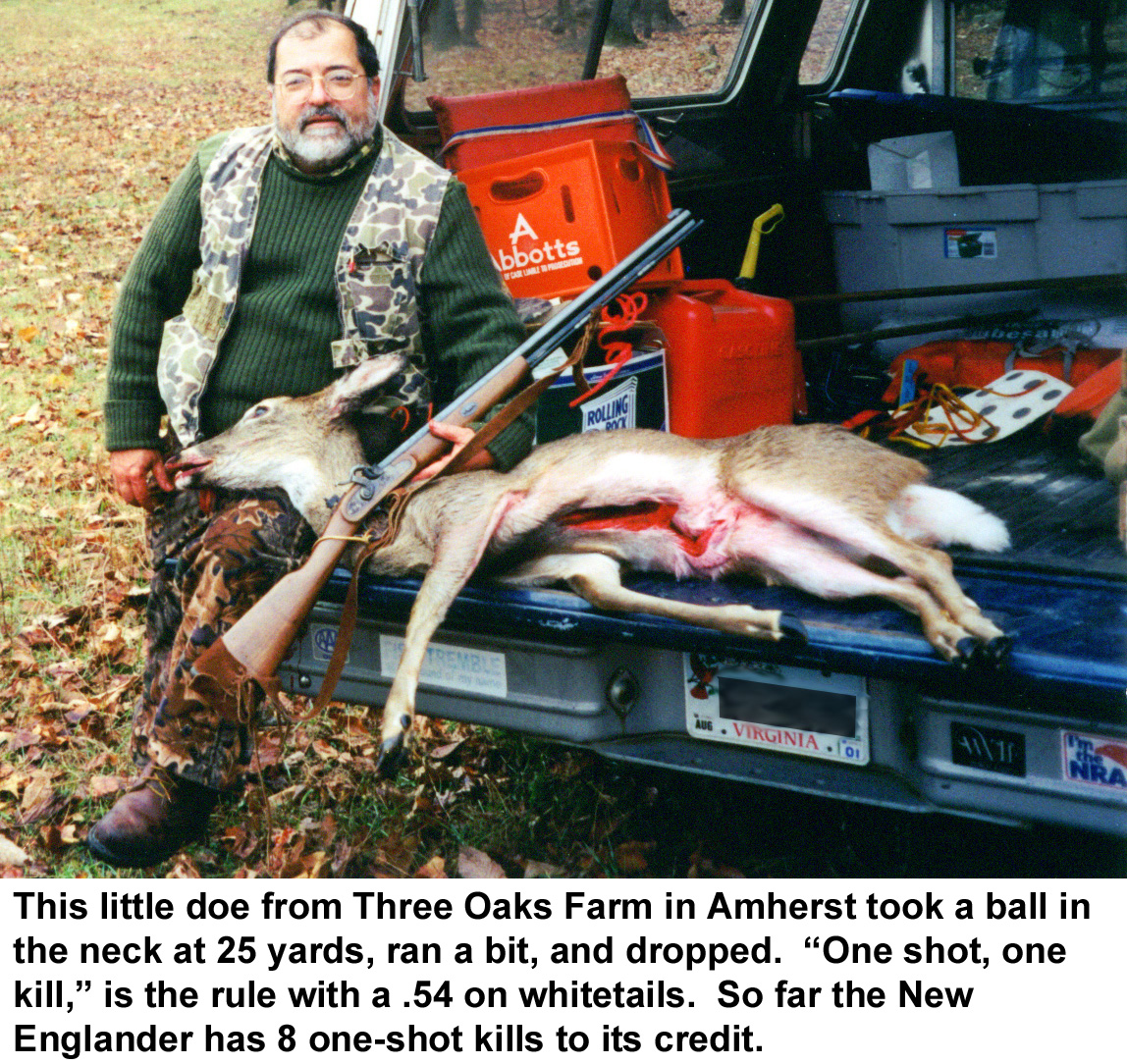 I went into the guest house, took a shower, scraped off the blood, cleaned my Ka-Bar, etc., called Mrs. Elitist to tell her the news, and started out to the main house for a drink with mine host. And lo, as I came out of the guest house, three more deer were standing on the lawn!
I went into the guest house, took a shower, scraped off the blood, cleaned my Ka-Bar, etc., called Mrs. Elitist to tell her the news, and started out to the main house for a drink with mine host. And lo, as I came out of the guest house, three more deer were standing on the lawn!
This had to be a Sign from The Goddess. It simply had to be: here I had reloaded my rifle and hadn't used the shot; here were three more deer, and I had my rifle to hand, needing only to be capped. So, bowing to Her wishes, I re-capped the gun and went to the end of the guest house porch. By this time it was 5:30, and getting dark. I thanked the Goddess for the fact that I had removed the disk from my peep sight and was using the mounting screw hole as a large diameter aperture; lined up the bead on a deer's neck, BOOM, and he dropped stone dead.
This shot was later paced off at 80 feet. The half-grown fawn got the ball in the neck, exactly where I had aimed: the neck was...well, "wobbly" and I could hear the bones in it grate when I moved it. A quick gralloch by lantern light, during which Rick came out...sans deer.
"I heard you shoot."
"Yeah, I shot at a big buck, but he got up and ran off. I found some hair and blood, and I came back to get a light to track him with."
I was too busy gutting and dragging Segunda to the tool shed to help; Rick was out searching for an hour and a half and then came back, again deer-less.
"Well," I said, "it's going to be cold, you can find him in the morning."
He did. After a couple of drinks and supper I was dead to the world, and by the time I got up at 7:00, Rick had been in the woods and tracked the buck down. He'd fallen not 30 yards from where I had shot the doe. Rick’s New Englander is a .50-caliber. His ball had hit the deer from the front, just behind the right shoulder blade, and run all the way to the left hind quarter, where it exited! The exit wound had been chewed a bit by scavengers, but the carcass was in perfect shape otherwise. A very nice 6-pointer, with an oddly-shaped high rack whose main tines almost touched.
In the intervening years, my New Englander has proven to be a lucky gun. It's “made meat” eight times so far and will hunt with me every BP season until I stop hunting. It has taken five deer in Amherst, one on Spruce Run Farm, and one on another property in Giles County. It seems to prefer does: five of the eight were females. (The Blazer killed three bucks, all at Spruce Run Farm, in two years.) Regardless of caliber, all of these eleven animals were one-shot kills.
Muzzle loading rifles can be frustrating but they’re also very satisfying to hunt with. They do improve a hunter’s most important asset, patience. And I've decided I like sidelocks. While I have no problems with “modern muzzle loaders” that never misfire, and wear optical sights, I enjoy "doing it the old-fashioned way" with a rifle that is pretty much like those of Yesteryear. The T/C products are first-class: I've recently bought a Renegade flintlock to play with, too. T/C's manufacturing methods and quality control far surpass those of even the best makers of the Mountain Man era, and I believe that Jeremiah Johnson would have been delighted if he'd been able to get his hands on one of these rifles.
My only gripe about the "modern" muzzle loading rifles is the way they're hyped and marketed. They're presented to Joe Public as near-equivalents to centerfire rifles (which they aren't even though they look like them). In my opinion this has resulted in a lot of people who've pushed the envelope and taken shots they should have avoided. The smokeless-powder and electric-ignition versions...well, let's just say I don't think they're "in the spirit of the game," at all.
I also have to say I miss the “good old days” of the early 90s BP season, when Virginia's rules prohibited the use of in-lines and scopes. The BP season then was a couple of weeks when I could hunt in the National Forest and rarely if ever encounter anyone else. The DGIF decision to allow in-lines didn’t change things all that much: but the decision a year later to permit scopes really altered the BP season. Everybody and his brother decided to get into the game and get those extra weeks of deer season—I don’t blame them, that’s exactly why I did it, too—and something was lost in the process, that relatively peaceful and almost contemplative style of hunting. The new rifles are as reliable as a muzzle loader can be, but things just aren't the same.
| HUNTING | GUNS | DOGS |
| FISHING & BOATING | TRIP REPORTS | MISCELLANEOUS ESSAYS |
| CONTRIBUTIONS FROM OTHER WRITERS|
| RECIPES |POLITICS |